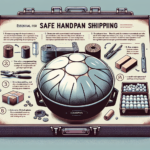Introduction
The handpan, a unique and mesmerizing instrument, has become increasingly popular among musicians and sound enthusiasts alike. With its ethereal sound and expressive range, the handpan captivates audiences and players. But what if you want to enhance your handpan’s sound for recording or live performances? This is where pickups come into play. This comprehensive guide will explore everything you need to know about using pickups to elevate your handpan experience.
Understanding Handpan Pickups
A pickup is a device that captures the vibrations of an instrument and converts them into an electrical signal. This signal can then be amplified, recorded, or processed. For handpans, pickups can open up a world of possibilities. They allow for amplification in live settings, provide clearer sound for recordings, and enable the use of effects pedals and other audio equipment.
Types of Handpan Pickups
There are primarily two types of pickups suitable for handpans: contact pickups and microphone-based pickups.
Contact Pickups
Contact pickups, also known as piezo pickups, work by detecting the vibrations of the handpan’s surface directly. These pickups offer a natural and undistorted sound, making them an excellent choice for handpans. They are typically small, easy to install, and do not require significant modifications to the instrument.
Microphone-based Pickups
Microphone-based pickups, as the name suggests, use a microphone to pick up the sound of the handpan. These can either be internal or external microphones. Internal mics are installed inside the handpan, while external mics are positioned outside the instrument, often clipped or mounted nearby. While they can provide a rich and detailed sound, they are generally more sensitive to ambient noises.
Choosing the Right Pickup
Selecting the right pickup for your handpan depends on various factors including the handpan’s material, your playing environment, and the intended use.
Material of the Handpan
The material of the handpan can affect how well a pickup functions. For example, piezo pickups work exceptionally well with metal surfaces, making them an ideal match for most handpans, which are generally made of steel. However, for handpans made from different materials, experimenting with different pickup types may be necessary to achieve the best sound quality.
Playing Environment
Your playing environment will also play a significant role in your choice of pickup. If you often play in noisy environments, a contact pickup might be a better option as it is less sensitive to ambient sounds compared to a microphone-based system. Conversely, in a controlled studio setting, a high-quality microphone-based pickup can capture the nuances of your handpan’s sound.
Intended Use
Consider what you intend to do with the amplified sound. If you’re looking to perform live, an easily mountable option that integrates well with PA systems might be your best bet. For recording purposes, the clarity and quality of sound will be your priority, potentially making a high-quality microphone-based pickup more suitable.
Installation and Setup
Installing a pickup on your handpan requires careful consideration to avoid damaging the instrument while ensuring optimal sound pickup. Here is a brief guide on how to install and set up both contact and microphone-based pickups.
Installing Contact Pickups
Contact pickups are usually attached to the outer surface of the handpan using adhesive or a mounting clip.
- Step 1: Clean the Surface – Make sure the surface where the pickup will be attached is clean and free of dust or oils.
- Step 2: Positioning – Position the pickup on the handpan, generally near the center for even sound pickup, but experimentation might be necessary for optimal placement.
- Step 3: Attach the Pickup – Secure the pickup using the provided adhesive or mounting clip. Make sure it’s firm and stable.
Installing Microphone-based Pickups
Microphone-based pickups require more precise positioning and are sensitive to placement.
- Step 1: Choose the Position – Determine whether you prefer an internal or external mic setup. For internal mics, professional installation is recommended. For external mics, find a position that captures the best sound and minimizes unwanted noise.
- Step 2: Secure the Microphone – Mount the microphone using a stand or clip. Ensure it’s stable and at an appropriate distance from the handpan to capture the desired tones.
- Step 3: Test and Adjust – Play your handpan and make any necessary adjustments to the mic position to achieve the best sound quality.
Amplification and Effects
Once the pickup is installed, the signal can be amplified and processed through various audio equipment. This opens up creative possibilities and enhances your handpan performance or recordings.
Amplifiers
Choose an amplifier that complements the natural sound of your handpan. Acoustic amplifiers are often preferred as they provide a clear and undistorted output. Experimenting with different amps can help you find the perfect match for your desired sound.
Effects Pedals
Effects pedals can add an extra layer of creativity to your handpan music. Reverb and delay pedals can enhance the ambient quality of your handpan, while loop pedals allow you to build complex layers of sound. Ensure the effects you choose blend well with the natural tones of your handpan.
Recording Your Handpan
Recording a handpan with a pickup involves a few additional steps to ensure the highest sound quality.
Setting Up Your Recording Environment
Create a controlled environment to eliminate unnecessary background noise. Soft furnishings and acoustic panels can help reduce sound reflections and create a cleaner recording space.
Using a DAW
Digital Audio Workstations (DAWs) like Ableton Live, Logic Pro, or Audacity can help you record and edit your handpan music. You’ll need an audio interface to connect your pickup to your computer. Experiment with different recording settings to capture the best possible sound.
Maintenance and Troubleshooting
Regular maintenance and troubleshooting ensure your pickup continues to perform optimally.
Regular Checks
Regularly check the attachment of your pickup. Over time, adhesives can weaken, so it’s crucial to ensure the pickup remains securely attached. For microphone-based systems, make sure the mic and cables are in good condition and properly connected.
Troubleshooting
If you encounter issues with your pickup, here are a few troubleshooting tips:
- Check Connections – Ensure all cables are securely connected and free of damage.
- Adjust Placement – If the sound quality is poor, experiment with different pickup or mic placements.
- Test Equipment – Test your amplifier, effects pedals, and recording equipment to rule out external issues.
Conclusion
Enhancing your handpan’s sound with pickups offers a myriad of possibilities for both live performances and recordings. By understanding the different types of pickups, how to choose the right one, and properly installing and maintaining them, you can elevate your musical expression. Whether you’re a professional performer or a passionate hobbyist, the right pickup can transform your handpan experience, allowing you to explore new sonic landscapes and connect with your audience on a deeper level.
FAQs
1. What is the best type of pickup for a handpan?
The best type of pickup depends on your specific needs. Contact pickups are generally well-suited for live performances due to their low sensitivity to ambient noise. Microphone-based pickups can provide a richer sound for studio recordings.
2. Will installing a pickup damage my handpan?
If installed correctly, pickups should not damage your handpan. Always follow the manufacturer’s instructions and, if unsure, seek professional assistance.
3. Can I use effects pedals with my handpan pickup?
Yes, you can use effects pedals with your handpan pickup to enhance your sound. Reverb, delay, and loop pedals are popular choices among handpan players.
4. Do I need an amplifier for my handpan pickup?
An amplifier is essential if you’re performing live, as it helps project your sound to a larger audience. Choose an amplifier that complements the acoustic qualities of your handpan.
5. How do I reduce feedback when using a handpan pickup in a live setting?
To reduce feedback, position your amplifier and speaker away from the handpan and use a feedback suppressor if necessary. Adjusting the EQ settings on your amplifier can also help manage feedback.





